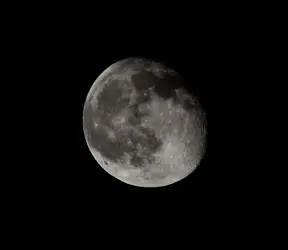The measured abledo of the moon is 0.12, very similar to worn asphalt. So your second image is more realistic than your first. Of course, we are used to seeing the moon as "bright", so that is how most of us tend to photograph it.
When shooting an astronomical object like the moon, the depth-of-field is not an issue, since the object is effectively at infinity as far as the lens focus is concerned. So the choice of aperture is usually more related to the aperture range over which your lens is sharpest. For many lenses that is at or near f/8. However, if you ARE shooting something in the foreground that needs to be in focus as well, then you do have to use a higher value aperture to get enough DOF, AND you need to place your focus so that the foreground object is within the acceptable DOF. This is effectively hyperfocal focusing.
Since the moon is, by definition, always in direct sunlight (except during eclipses), and is about the same distance from the sun as we are, the same exposures as for use during the noon-time day can be used. Of course, atmospheric extinction plays a role, so the previous sentence is true when the moon is high in the sky, and as the moon gets closer to the horizon, you need to adjust the exposure accordingly.
The moon is also a rather small object, and most of the time, you'd need to magnify the image to get a decent amount to fill the frame. You can do this magnification either by using a longer focal length, or by cropping and enlarging. Of course, any blur due to motion (either camera or moon) will be magnified as well. So the usual recommendation is to use at least a tripod, to minimize the issues with camera shake blur. If you shoot the moon with a very long lens, or through a telescope, then the apparent motion of the moon across the sky becomes significant enough to require either a fast shutter, or a tracking mount.
Due to the moon's brightness and small size, using the native ISO is usually be best way to ensure a smooth-enough image that can be enlarged (or cropped) without enlarging the noise as well. White balance can be pre-set for daylight, unless the moon is close to the horizon, in which case it will appear redder due to atmospheric scattering of blue.



















